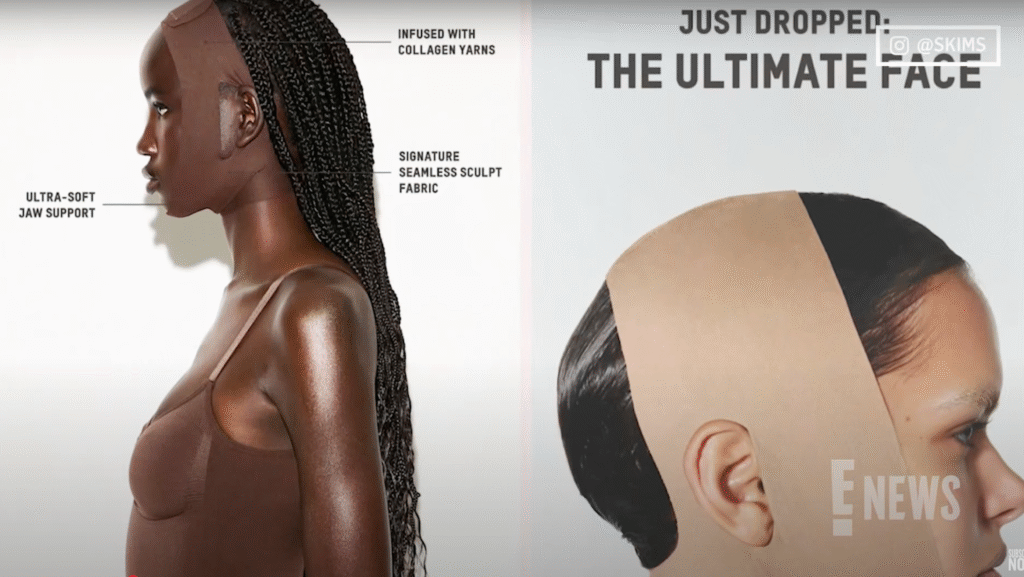Business
Kim Kardashian’s Viral Face Wrap: Beauty Breakthrough or $50 Gimmick?

The SKIMS Seamless Sculpt Face Wrap—Kim Kardashian’s latest viral shapewear for the face—has exploded in popularity, stirring both fascination and skepticism. This $48–$50 “face bra” is billed as a sleep-friendly compression wrap engineered to lift, sculpt, and define the jawline overnight, stirred by TikTok beauty trends and the enduring cultural obsession with defeating aging. While it immediately sold out after launch, expert consensus and historical context suggest the effectiveness of such beauty devices remains highly questionable, repeating a long lineage of similar fads that have thrived on marketing more than meaningful results.

What Is the SKIMS Face Wrap?
The SKIMS Seamless Sculpt Face Wrap is marketed as a first-of-its-kind facial shapewear, made from a blend of polyamide and elastane, infused with “collagen yarns,” and designed to apply targeted compression to the lower face and neck. The wrap’s purpose, according to SKIMS, is to “sculpt” the jaw overnight, inspired by post-surgery facial compression wear used medically after facelifts or jaw operations. It’s part of a surge in face-toning belts and jawline sculpting accessories, many echoing Korean beauty trends centered on the coveted V-line jaw shape.
Does It Actually Work?
Despite a flurry of influencer endorsements, the scientific support for these face wraps is minimal. Expert dermatologists and cosmetic doctors note that while compression can create a mild, very temporary slimming effect (by shifting fluids or briefly compressing soft tissue), these changes disappear within hours—similar to the fleeting effects of waist trainers. There is no credible evidence that any fabric wrap, regardless of its cost or “collagen infusions,” can structurally reshape the face or lift sagging tissues overnight. Prolonged use could even cause pressure marks, acne, or jaw tension. Form-fitting plastics or elastics strong enough to permanently alter bone or tissue would likely pose significant health risks.
The Viral Trend and Its History
The SKIMS Face Wrap’s viral success is driven by social media fads like TikTok’s “morning shed,” where users dramatically unveil layers of overnight beauty gear, boosting engagement and product sales. These “face bras” are far from new; generations before turned to all manner of overnight beauty masks, from Victorian “face gloves” to electrified rubber devices, often promising dubious anti-aging miracles. Beauty routines aiming to stave off wrinkles have a long, bizarre history steeped in both hope and clever marketing rather than functional science.
Beauty, Gimmicks, and Marketing
Kim Kardashian’s marketing strategy blends shock value with Instagrammable aesthetics, mirroring tactics used by brands like Goop and leveraging scarcity to drive hype and sales. Comparable to Goop’s “vagina candle” or SKIMS’ own “nipple bra,” the face wrap toes the line between self-aware gimmick and serious wellness product—winning viral attention, but without substantive evidence of long-term benefit.

Are There Better Alternatives?
Doctors recommend evidence-backed treatments—like high intensity focused ultrasound, collagen injections, dermal fillers, and properly applied neuromodulators (e.g., Botox)—for those truly seeking noticeable facial contouring. Cheaper, lower-risk home methods such as face massage or gua sha can provide short-lived improvements in skin tone and puffiness, though these too have modest outcomes.
Conclusion
The SKIMS face wrap is the latest in a centuries-long procession of beauty gadgets promising the “ultimate face.” While it wins points for marketing impact and momentary snatching, its claims of sculpting or age-defiance are unsubstantiated and temporary at best, with notable risk of irritation or discomfort. Like many viral beauty trends before it, the primary result for most is an emptier wallet and a fleeting selfie moment—rather than the timeless jawline of advertising mythology.
Business
Why 9 Million Americans Have Left

The Growing American Exodus
Nearly 9 million Americans now live outside the United States—a number that rivals the population of several states and signals a profound shift in how people view the American dream. This mass migration isn’t confined to retirees or the wealthy. Thanks to remote work, digital nomad visas, and mounting pressures at home, young professionals, families, and business owners are increasingly joining the ranks of expats.

Rising Costs and Shrinking Wallets
Living in the US has become increasingly expensive. Weekly grocery bills topping $300 are not uncommon, and everyday items like coffee and beef have surged in price over the last year. Rent, utilities, and other essentials also continue to climb, leaving many Americans to cut meals or put off purchases just to make ends meet. In contrast, life in countries like Mexico or Costa Rica often costs just 50–60% of what it does in the US—without sacrificing comfort or quality.
Health Care Concerns Drive Migration
America’s health care system is a major trigger for relocation. Despite the fact that the US spends more per person on health care than any other country, millions struggle to access affordable treatment. Over half of Americans admit to delaying medical care due to cost, with households earning below $40,000 seeing this rate jump to 63%. Many expats point to countries such as Spain or Thailand, where health care is both affordable and accessible, as a major draw.

Seeking Safety Abroad
Public safety issues—especially violent crime and gun-related incidents—have made many Americans feel unsafe, even in their own communities. The 2024 Global Peace Index documents a decline in North America’s safety ratings, while families in major cities often prioritize teaching their children to avoid gun violence over simple street safety. In many overseas destinations, newly arrived American families report a significant improvement in their sense of security and peace of mind.
Tax Burdens and Bureaucracy
US tax laws extend abroad, requiring expats to file annual returns and comply with complicated rules through acts such as FATCA. For some, the burden of global tax compliance is so great that thousands relinquish their US citizenship each year simply to escape the paperwork and scrutiny.
The Digital Nomad Revolution
Remote work has unlocked new pathways for Americans. Over a quarter of all paid workdays in the US are now fully remote, and more than 40 countries offer digital nomad visas for foreign professionals. Many Americans are leveraging this opportunity to maintain their US incomes while cutting costs and upgrading their quality of life abroad.

Conclusion: Redefining the Dream
The mass departure of nearly 9 million Americans reveals deep cracks in what was once considered the land of opportunity. Escalating costs, inaccessible healthcare, safety concerns, and relentless bureaucracy have spurred a global search for better options. For millions, the modern American dream is no longer tied to a white-picket fence, but found in newfound freedom beyond America’s borders.
Business
Will Theaters Crush Streaming in Hollywood’s Next Act?

Hollywood is bracing for a pivotal comeback, and for movie lovers, it’s the kind of shake-up that could redefine the very culture of cinema. With the freshly merged Paramount-Skydance shaking up its strategy, CEO David Ellison’s announcement doesn’t just signal a change—it reignites the passion for moviegoing that built the magic of Hollywood in the first place.

Theatrical Experience Roars Back
Fans and insiders alike have felt the itch for more event movies. For years, streaming promised endless options, but fragmented attention left many longing for communal spectacle. Now, with Paramount-Skydance tripling its film output for the big screen, it’s clear: studio leaders believe there’s no substitute for the lights, the hush before the opening credits, and the collective thrill of reacting to Hollywood’s latest blockbusters. Ellison’s pivot away from streaming exclusives taps deep into what unites cinephiles—the lived experience of cinema as art and event, not just content.
Industry Pulse: From Crisis to Renaissance
On the financial front, the numbers are as electrifying as any plot twist. After years of doubt, the box office is roaring. AMC, the world’s largest theater chain, reports a staggering 26% spike in moviegoer attendance and 36% revenue growth in Q2 2025. That kind of momentum hasn’t been seen since the heyday of summer tentpoles—and it’s not just about more tickets sold. AMC’s strategy—premium screens, with IMAX and Dolby Cinema, curated concessions, and branded collectibles—has turned every new release into an event, driving per-customer profits up nearly 50% compared to pre-pandemic norms.
Blockbusters Lead the Culture
Forget the gloom of endless streaming drops; when films like Top Gun: Maverick, Mission: Impossible, Minecraft, and surprise hits like Weapons and Freakier Friday draw crowds, the industry—and movie fans—sit up and take notice. Movie-themed collectibles and concession innovations, from Barbie’s iconic pink car popcorn holders to anniversary tie-ins, have made each screening a moment worth remembering, blending nostalgia and discovery. The focus: high-impact, shared audience experiences that streaming can’t replicate.
Streaming’s Limits and Studio Strategy
Yes, streaming is still surging, but the tide may be turning. The biggest franchises, and the biggest cultural events, happen when audiences come together for a theatrical release. Paramount-Skydance’s shift signals to rivals that premium storytelling and box office spectacle are again at the center of Hollywood value creation. The result is not just higher profits for exhibitors like AMC, but a rebirth of movie-going as the ultimate destination for fans hungry for connection and cinematic adventure.

Future Forecast: Culture, Community, and Blockbuster Dreams
As PwC and others warn that box office totals may take years to fully catch up, movie lovers and industry leaders alike are betting that exclusive theatrical runs, enhanced viewing experiences, and fan-driven engagement are the ingredients for long-term recovery—and a new golden age. The Paramount-Skydance play is more than a business move; it’s a rallying cry for the art of the theatrical event. Expect more big bets, more surprises, and—finally—a long-overdue renaissance for the silver screen.
For those who believe in the power of cinema, it’s a thrilling second act—and the best seat in the house might be front and center once again.
Business
Why Are Influencers Getting $7K to Post About Israel?

Influencers are being paid as much as $7,000 per post by the Israeli government as part of an expansive and sophisticated digital propaganda campaign. This effort is designed to influence global public opinion—especially among younger social media users—about Israel’s actions in Gaza and to counter critical narratives about the ongoing humanitarian situation.

How Much Is Being Spent?
Recent reports confirm that Israel has dedicated more than $40 million this year to social media and digital influence campaigns, targeting popular platforms such as TikTok, YouTube, and Instagram. In addition to direct influencer payments, Israel is investing tens of millions more in paid ads, search engine placements, and contracts with major tech companies like Google and Meta to push pro-Israel content and challenge critical coverage of issues like the famine in Gaza.
What’s the Strategy?
- Influencer Contracts: Influencers are recruited—often with all-expenses-paid trips to Israel, highly managed experiences, and direct payments—to post content that improves Israel’s image.
- Ad Campaigns: State-backed ad buys show lively Gaza markets and restaurants to counter global reports of famine and humanitarian crisis.
- Narrative Management: These posts and ads often avoid overt propaganda. Instead, they use personal stories, emotional appeals, and “behind the scenes” glimpses intended to humanize Israel’s side of the conflict and create doubt about reports by the UN and humanitarian agencies.
- Amplification: Paid content is strategically promoted so it dominates news feeds and is picked up by news aggregators, Wikipedia editors, and even AI systems that rely on “trusted” digital sources.
Why Is This Happening Now?
The humanitarian situation in Gaza has generated increasing international criticism, especially after the UN classified parts of Gaza as experiencing famine. In this environment, digital public relations has become a primary front in Israel’s efforts to defend its policies and limit diplomatic fallout. By investing in social media influencers, Israel is adapting old-school propaganda strategies (“Hasbara”) to the era of algorithms and youth-driven content.
Why Does It Matter?
This campaign represents a major blurring of the lines between paid promotion, journalism, and activism. When governments pay high-profile influencers to shape social media narratives, it becomes harder for audiences—especially young people—to distinguish between authentic perspectives and sponsored messaging.

In short: Influencers are getting $7,000 per post because Israel is prioritizing social media as a battleground for public opinion, investing millions in shaping what global audiences see, hear, and believe about Gaza and the conflict.

 Business4 weeks ago
Business4 weeks agoDisney Loses $3.87 Billion as Subscription Cancellations Surge After Kimmel Suspension

 Entertainment4 weeks ago
Entertainment4 weeks agoWhat the Deletion Frenzy Reveals in the David and Celeste Tragedy

 Entertainment4 weeks ago
Entertainment4 weeks agoExecutive Producer Debut: How Celia Carver Created Festival Hit ‘Afterparty’

 Health4 weeks ago
Health4 weeks agoRussia Claims 100% Success With New mRNA Cancer Vaccine

 Business3 weeks ago
Business3 weeks agoWhy Are Influencers Getting $7K to Post About Israel?

 Health4 weeks ago
Health4 weeks agoWhy Did Gen Z QUIT Drinking Alcohol?

 Advice4 weeks ago
Advice4 weeks agoHow AI Is Forcing Everyone Into the Entrepreneur Game

 Entertainment3 weeks ago
Entertainment3 weeks agoKeith Urban and Nicole Kidman Split After 20 Years as Actress Files for Divorce







































